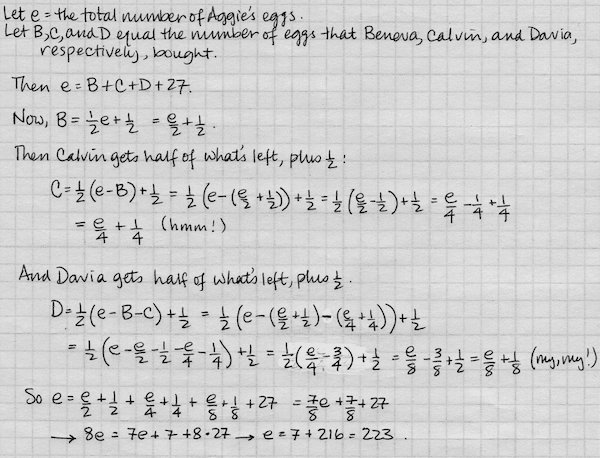Aggie sells eggs. Last Saturday she sold Beneva half her eggs plus half an egg. Then she sold Calvin half of her remaining eggs plus half an egg. Then she sold Davida half of her remaining eggs plus half an egg. Then she sold the remaining 27 eggs to you. How many eggs did she start with?
Solution
Discussion: This is a nifty problem. It can be solved with nothing but arithmetic, but there's some algebra that works too (if one wants to bother). It can be generalized in interesting ways, to boot.
Solving the Problem: The first thing to get out of the way, of course--the first bump in the road--is the business of "half an egg" (see below). The bright idea is that if she has an odd number of eggs, half of them will involve half an egg right there, so "half of her eggs plus half an egg" comes out to a whole number of eggs.
It's possible to set up an equation for this. Let equal the total number of eggs. Then what B got plus what C got plus what D got plus 27. This is a right amount of work to set up, and it works. It is worked out in the figure below.
A better way is to start at the end and work backwards. She sold half of her eggs plus half an egg to Davida, and there were 27 eggs left over for you. That means that the 27 eggs are half an egg fewer than what she had before she made the sale to Davida. So double the 27 ½ and we get 55. She sells Davida half of 55 plus ½, which is 27 ½ plus ½ or 28, and 55 - 28 = the 27 for you. So we're OK so far.
Now, continuing, Aggie sold half her eggs plus half an egg to Calvin, and had 55 left over. So, again, 55 is half an egg less than half of what she had before she made her sale to Calvin. So 55 ½ is exactly half, and so she had 111 eggs before selling any to Calvin; he got 56.
So 111 eggs were left over after the sale to Beneva, and, again, 111 must have been half an egg less than half of her eggs. So she must have started with 223 eggs, and Beneva got 112.
Checking: 223 - 112 - 56 - 28 = 27.
Heuristics: #12, work backwards, and, incidentally, #13, identify sub-goals. #10, write an equation, works too. Finally, the problem can be done with #2, guess and try, by setting up a spreadsheet and plugging in guesses for the initial number of eggs.
Using the Problem with Students:
a. spread over several days. This is a fun problem to throw at a class, because of the issue of half an egg. There will be questions about whether the eggs are hard-boiled, or maybe made of wood or ceramic. But no, they are fresh, raw, farm eggs. I just leave the class to puzzle it out, until somebody comes up with the right idea. I never give it away. It might be days before this is settled. Or, you can start (once they've given up on hard-boiled eggs) by asking them for an example of a small number of eggs. If a student says six, well, half of that is three plus half an egg makes a mess. When a student says an odd number like seven, the light bulb comes on: half of seven is three-and-a-half, plus half an egg is four. Ah!
Once that's done, I want to make sure that the class sees that a good way to proceed is to start at the end with the 27 eggs and work backwards. Depending on the level of the class, they can take it from there, or maybe they'll need a little help. But I try to leave them on their own as much as possible, and let the problem drag out over more than one day. (A few minutes out of regular class time to check progress and give hints is what I mean by "more than one day"--not to be unduly intrusive on the regular work of the class.) Once the answer has been found, I take some time to make sure everybody sees how to work back through the story to get it.
Modifying or Extending the Problem: First of all, the number of eggs that "you" get can be any odd number, right? Is there some formula relating the number of eggs you get at the end, to the number that Aggie has at the beginning? How does this relate to the number of customers she has throughout the story? What if she sells some eggs to Evaline after the sale to Davida and before she sells the rest to you? Is there some sort of a grand formula using the number of eggs you get at the end, and the number of sales Aggie makes, that can generate the number of eggs she starts with? And--ulp--what if some other fraction besides one half is involved?
Remarks: I find that students who have gotten the hang of writing equations for problems want to do it all the time. If your students still think that equations are the best way to go, take them through the formidable process of writing the equation for this problem, and thus encourage them to be on the lookout for other methods. (It's an interesting equation, though.)
